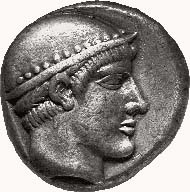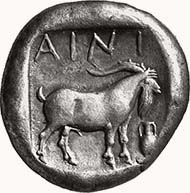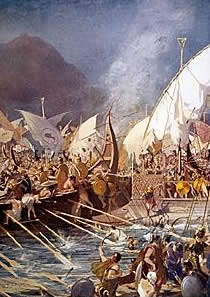by courtesy of Dr. Hans Voegtli / ACAMA
AINOS. Tetradrachmon, 460-440. Kopf des Hermes mit nietenbesetztem Petasos n. r. Rv. AINI Ziegenbock n. r. stehend, vor ihm Amphora; alles in Quadratum incusum. 16,30 g. May 41, 32 (Av. stgl.).
Ainos, today called Enez and located on the border of the Aegean Sea in the European part of Turkey, didn’t have any important resources. As far as we know, there also didn’t exist any remarkable industry. Ainos reached incredible wealth during the 5th century B.C. despite these facts. The convenient location of the city was the reason for that. Ainos had an easily accessible harbor and was situated on the border of river Hebros navigable in ancient times. The hinterland was famous for its fertile fields, the short time the seed needed for ripening and the heavy weight of the ears. Hebros made these fields accessible. The crop was shipped directly to Ainos, from there it was traded and sent all over the Greek world. The sought-after Greek luxury goods went the same way to the Thracian tribes, who paid for that merchandise with their corn and their silver. Ainos became rich being the most important trading point between the Aegean Sea and Thrace.
No wonder that the Persians wanted to control this rich and important area. In 512 they founded Doriscos castle for that reason. It was situated in the neighborhood of Ainos, slightly inland on a ford of river Hebros. Ainos was forced to pay tribute to the Persians and to provide ships for the war with Athens, which were brought into action
at the battle of Salamis. But the Persian influence slowly diminished in Thrace. 478 Sestos was conquered, 477/6 Pausanias was expelled from Byzantion. But there still was the fortress Doriscos controlling its neighborhood.
Ships from Ainos fought on the Persian side in the battle of Salamis.
Scholars have tried to connect the beginning of the Ainos mint with the
end of the Persian rule. But we have no information that Ainos changed
sides. May thought that Ainos aligned with Athens immediately after the
fall of Byzantion. After the liberation of Ainos from the Persian yoke,
the trade – according to the opinion of May – concentrated there and
the free and rich city started to strike coins. But the first reliable
record of Ainos being member of the Athenian confederacy originates
from the year 454/3! There also exist some strange indications showing
the theory of May in completely new light.
Our coin was minted during the first period of coinage in Ainos. It
weighs 16.30 g. This weight doesn’t match with the Athenian standard.
Our coin is – like all the other tetradrachms of Ainos during that
period – much too light. But its weight can easily be brought into
harmony with the standard of Persian coins. One siglos weighs 5.50 to
5.40 g. Our tetradrachm corresponds to three sigloi. We can infer that
the coinage of Ainos was organized according to the Persian monetary
system. Probably this was caused by the political reality. The
beginning of coinage doesn’t have to mean automatically the end of
Persian supremacy.
Comparing the situation of other Greek cities, we can see that under Persian rule nobody was forced to stop its production of coins. On the contrary, never and nowhere existed more and more manifold series of coins than in Asia Minor under Persian “oppression”. Of course, the Persians demanded tribute, but we do not know whether their demands were higher than the twelve talents of silver Ainos was forced to pay to Athens in 454/3. In any case, the Persian yoke was probably much lighter than the yoke of the Greek brother nation. We have to stress it again and again: It was not the Persian king who forced his subjects to stop minting coins. It was the democratic city of Athens, symbol of liberty, who tried to force her allies to give up their own money and to use the Athenian owls exclusively. This fact should make us think about the successful propaganda of Athens, which praised the city as stronghold of liberty, democracy and culture. The victor writes the history, but it is not always the true one.
I. Carradice, Coinage and Administration in the Athenian and Persian Empires, BAR 343 (1987)
J. M. F. May, Ainos. Its history and coinage 474-341 B.C., London, 1950.
L. Mildenberg, Über das Münzwesen im Reich der Achämeniden, AMI 26 (1993) 55-79 oder Vestigia Leonis (1998) 3-30.






